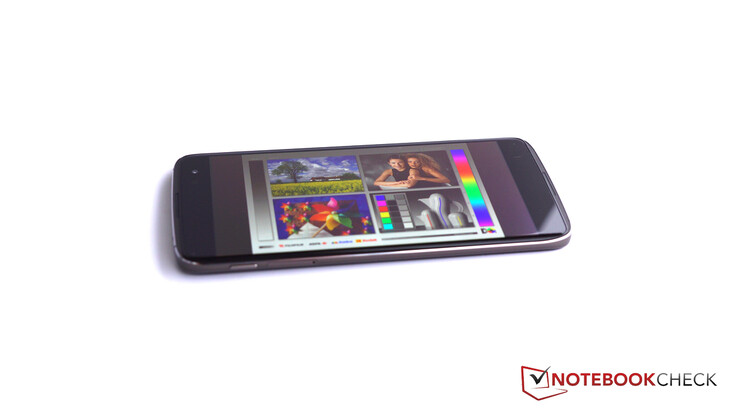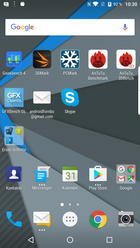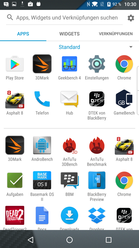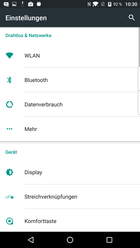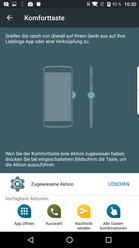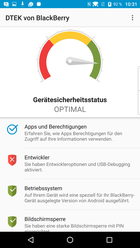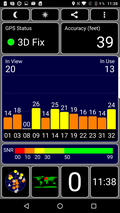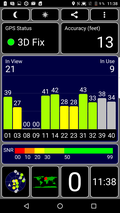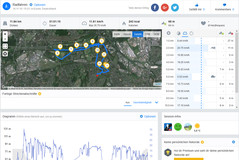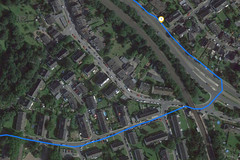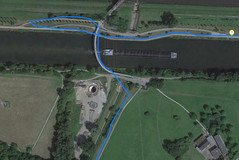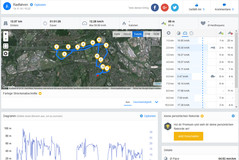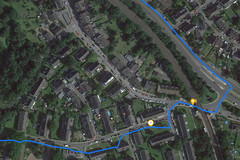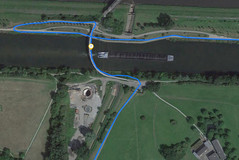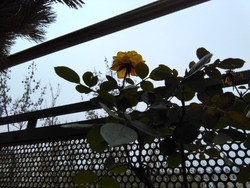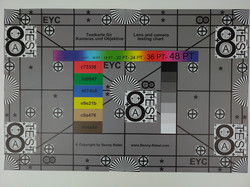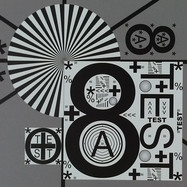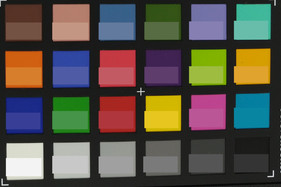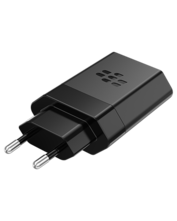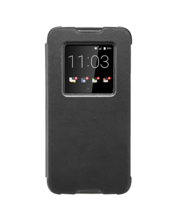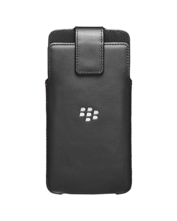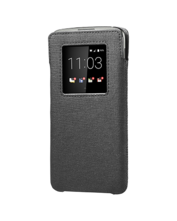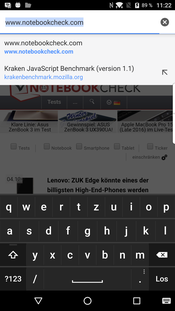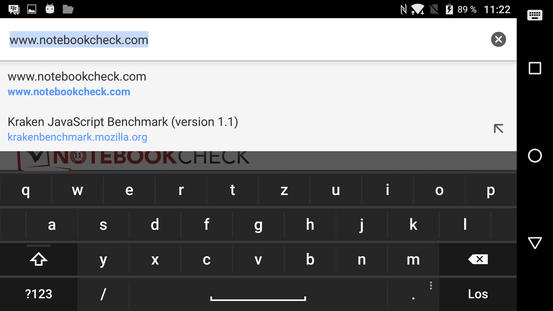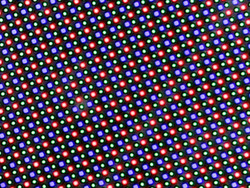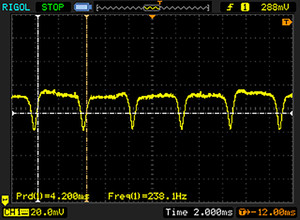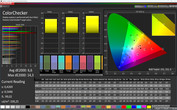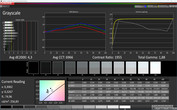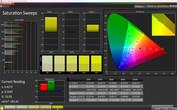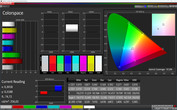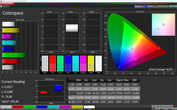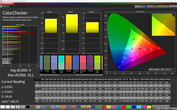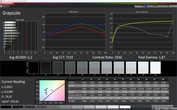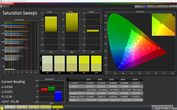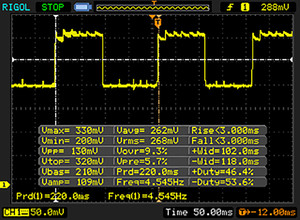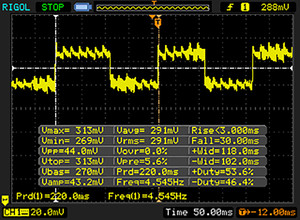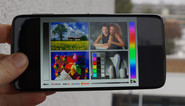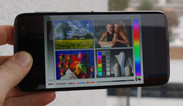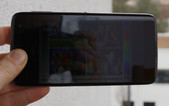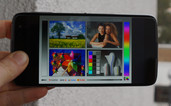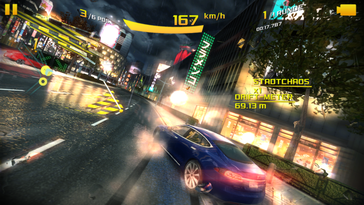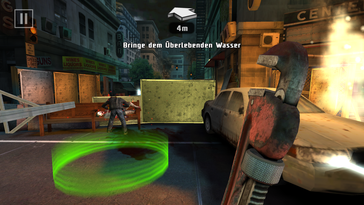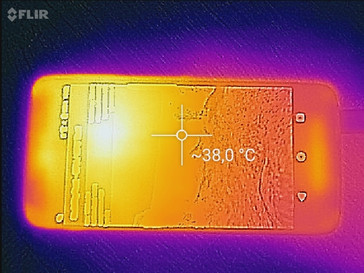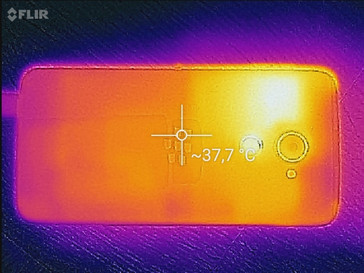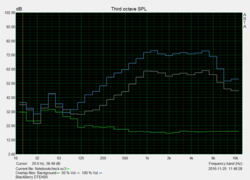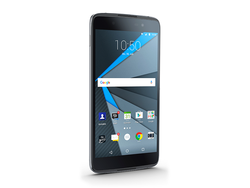BlackBerry DTEK60 Smartphone Review
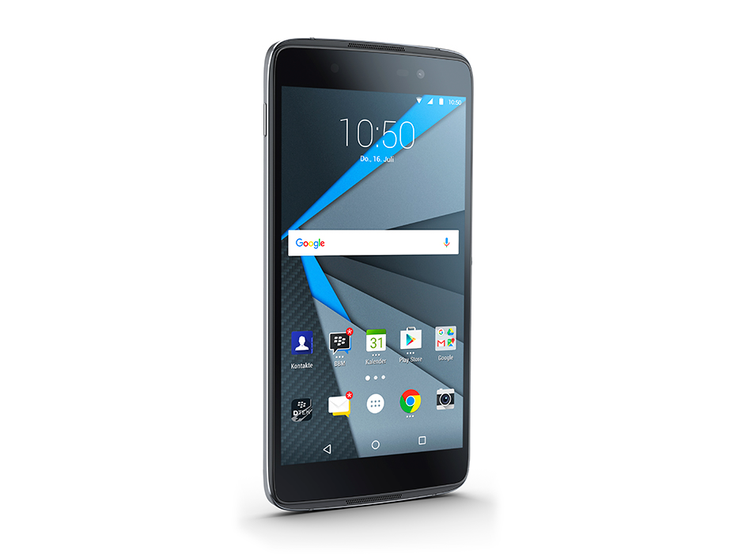
For the original German review, see here.
BlackBerry doesn’t make smartphones any more. Or does it? We tested the Canadian company’s new flagship model, the DTEK60. Alcatel (a subsidiary of the Chinese electronics giant, TCL) now handles the actual manufacturing and BlackBerry, which shut down its hardware-design operations last year, develops the software and sells the devices under their brand.
Accordingly, the DTEK60 looks noticeably different from the previous BlackBerry models, particularly the prominent speaker design. BlackBerry still chooses to operate exclusively on Android smartphones, which are regarded as particularly secure and thus of greater appeal to business clientele. To that end, BlackBerry promises to release rapid and frequent security updates for its devices.
We’ve already tested the somewhat smaller, weaker equipped (and thus cheaper) sister model, the DTEK50. That model proved to be a solid mid-tier phone with many security features, even if at times they caused incompatibility issues. As to how the DTEK60 performs, we’ll find out now.
Our test model retailed for approximately 579 Euros (~$605). Not quite as expensive as the iPhone 7 Plus, but perhaps it can offer similar performance? The OnePlus3 is also an interesting option - less expensive yet still elegantly constructed. We also consider the Huawei P9 Plus and Samsung Galaxy S7 Edge, as well as the extremely expensive Google Pixel X as major competitors in this segment.
Case
The BlackBerry DTEK60 cuts quite a stylish figure, and at a meager 165 g it isn't too heavy in the hand either. Its weight and dimensions are about average for the 5.5-inch smartphone class, and the design is rather symmetrical, with front and rear glass panels sandwiching the metal body. The loudspeakers are placed prominently above and below the glass panels, and they project sound both forwards and backwards. The design is unusual yet stylish, and with its rounded corners the BlackBerry DTEK60 feels comfortable to hold.
The phone's body is of high-quality construction, flexing slightly under pressure. The DTEK is available in only one style - an elegant black encased by a dark metallic gray border.
Connectivity
A USB-C connection is the physical connection between the BlackBerry DTEK60 and the outside world. Unfortunately, the interface only supports USB-2.0 data transfer speeds (USB-OTG). The 4 GB RAM is typical for this price class, as is the 32 GB flash storage, which can be expanded through the available microSD-card slot. However, BlackBerry does not allow apps to be stored on microSD-cards, perhaps out of security concerns. Tip: It is possible to bypass this by reformatting the microSD-card, which allows the card to be utilized as internal storage. As a nice touch, the phone does automatically download the required driver should an exFAT-formatted microSD-card be used.
Software
BlackBerry decided to use Android 6.0, which is not quite the newest version of the Google mobile operating system. The security patches on our test device were roughly one month old. The Canadian manufacturer was, of course, once a heavyweight in the business-smartphone market, hence the central role that security plays in all BlackBerry devices. In the new DTEK devices, this security aspect is elevated even more so through the namesake "DTEK" application, which essentially bundles the native Android security features and makes them easily accessible for the end user.
However, that is not without problems: On one hand, there is a slight performance drain, most likely due to the constantly running System Scan application, and on the other hand there tended to be incompatibility issues with apps that need deep system access, such as to view the phone's benchmarks. As these apps are denied the access permissions they require, they either do not start or crash after opening. Yet on the whole, the "DTEK" software certainly can help simplify the task of keeping one’s phone secure. There are also a few additional security mechanisms available, such as data encryption and the ability to schedule system and boot-loader scans whenever the phone boots up. Further details can be found in our review of the BlackBerry DTEK50.
That’s also where you can read about BlackBerry’s plans to maintain a rapid update schedule to help ensure the security of its devices. The results of this effort have been somewhat mixed, however, the DTEK60 has at least thus far been more reliable than the DTEK50.
BlackBerry also installs a number of productivity apps, such as a task manager, a calendar, their own messenger, and the BlackBerry Hub, where emails and notifications from other messenger apps, phone calls and text messages are bundled together in one interface.
Communication and GPS
The BlackBerry DTEK60 supports four GSM, four UMTS, and 13 LTE bands. In this regard it lies somewhat behind the iPhone 7 Plus, but in Europe at least one should have no issues with network connectivity. Download speeds are also not quite as fast as those of top models in the class: a maximum 300MB/s should be easily sufficient for most daily tasks. In inner-city areas, cellular reception on the well-built Vodafone network was solid, and even indoors we enjoyed almost full LTE reception.
The Wi-Fi module supports 802.11 a/b/g/n/ac and thus all the most currently used standards. Even communication over the less frequently used 5 GHz range is possible. BlackBerry's new flagship did show its limits in our standardized data transfer speed tests, lagging far behind the Google Pixel XL. Other comparable phones within the same class are also noticeably faster, particularly with respect to sending data.
In practice tests, we had full reception near the router, and at 10 meters' distance, through three walls, we still had 3/4 signal strength. Webpage loading in both cases was quick and responsive.
| Networking | |
| iperf3 transmit AX12 | |
| Google Pixel XL 2016 | |
| Samsung Galaxy S7 Edge | |
| OnePlus 3 | |
| BlackBerry DTEK60 | |
| iperf3 receive AX12 | |
| Google Pixel XL 2016 | |
| OnePlus 3 | |
| BlackBerry DTEK60 | |
| Samsung Galaxy S7 Edge | |
With the assistance of the "GPS Test" app, we were able to test the precision of the phone's location services. First we tested indoors, where the BlackBerry smartphone was only able to determine a location when near a window, and even then with accuracy only to 12 meters. In the open outdoors, the accuracy increased, after a brief wait, to within five meters.
We were able to get an even more complete picture of the BlackBerry DTEK60's capabilities after we took the phone on a 12-kilometer bike ride alongside the Garmin Edge 500, a professional-grade navigator. Both devices had, in practice, their outliers, but it was readily apparent that the satellite signal was more frequently picked up by the Garmin Edge 500 than by our test device. However, for everyday use, the DTEK60's accuracy should suffice.
Telephone and Voice Quality
For telephone functionality, BlackBerry relies on the standard phone application from Google. That is, of course, hardly a bad choice, and past Android users will quickly find themselves at home. The app is well-designed, with a large button at the bottom of the screen which can be used to call up the dialpad at any time, and the application launches by showing favorite contacts. Contacts and recent calls can also be easily accessed via buttons on the top.
Voice quality is, unfortunately, somewhat lacking: the microphone was able to pick up even soft speech, but the tradeoff was that we sounded distant and somewhat tinny on the receiver's end. We were also unable to hear the other party very clearly, not due to background noise, but rather because the sound was reproduced with almost no bass and sounded quite thin.
The voice quality via loudspeaker was, however, an entirely different matter. Here, the other party sounded incredibly present, with a warm, full sound. The microphone can pick up quiet sounds in this mode, but the receiver still complained of very tinny sound reproduction.
Cameras
The BlackBerry DTEK60 is well-equipped with a 21-megapixel camera in the rear and an 8-megapixel lens in the front. The rear-facing camera is even capable of recording 4K videos at 30 frames per second, and in high quality: quick movements were fluidly captured, and the phone readily handled both lowlight and changing-light conditions. The front camera is capable of recording videos in 1080p, and here the picture quality was also solid.
Pictures taken with the main (rear) camera can be illuminated with a dual-LED flash, which is standard for the class. The flash isn't always necessary, as even without it the pictures were relatively sharp, although lighter surfaces tended to dominate. While there are definitely smartphone cameras with better picture quality under poor lighting conditions, such as the Samsung Galaxy S7, the BlackBerry DTEK60 performs above average for its class.
In daylight, the camera produced natural, if not particularly warm colors (particularly not in the winter). Those who would prefer warmer picture reproduction can certainly correct that manually, as BlackBerry's camera app offers an appropriate mode for doing so. Blurring was especially noticeable at the edges, but otherwise the picture quality was quite good. All in all, we rate the camera picture quality also as middle of the pack.
The front camera takes rather sharp pictures, with accurate color reproduction, making it quite well-suited for selfies under normal lighting conditions.
We tested the main camera once again, this time in the lab under controlled conditions. Here, the color reproduction proved somewhat too dark. The test chart showed minor problems with outlining colorful surfaces, and the blurring at the edges was also still evident. In all, the phone's results were solid but hardly state-of-the-art.
Accessories and Warranty
BlackBerry includes an AC charger, a USB-C cable, a headset, a SIM tool and a few leaflets covering technical data. That's all pretty much standard issue for smartphones in this price class.
On the BlackBerry website one can find a wide selection of cases, travel chargers with different adapters for as little as 40 Euros (~$41), or cable headsets for just 30 Euros (~$31), with cables also available in gold.
The Smart Flip Case offers a viewing window through which important information can be seen when the case is closed. One can even hold phone conversations while the case, which BlackBerry is offering for 50 Euros (~$52), is closed. For those that prefer to have a sleeve for their smartphone, while still protecting the glass screen, the 10-Euro (~$10) cheaper Smart Pocket is also offered. BlackBerry recommends the holster, as radiation exposure to the body is reduced. The holster is available for 50 Euros (~$52).
BlackBerry offers a 24-month warranty on the phone. Please see our Guarantees, Return Policies & Warranties FAQ for country-specific information.
Input Devices
The BlackBerry keyboard is easy to hold and feels similar to the standard Google one, although the individual keys are more clearly separated from one another and the standard layout is dark with white letters. We could quickly and precisely type with BlackBerry's keyboard, as well as easily switch to other apps.
Input via the touchscreen was also very precise, and even in the corners input was effectively recognized. The menu buttons are blended into the screen; there is a standby key on the side, volume controls, and one round configurable button that is reminiscent of Sony's smartphone designs.
BlackBerry also allows swipe gestures to be used to quickly open certain apps, and it's possible to unlock the phone using the fingerprint sensor on the back of the phone, which was easy to use and worked effectively in our tests.
Display
More and more smartphone manufacturers, at least when it comes to high-end phones, turn to AMOLED displays, which generally offer excellent viewing angles, absolute blacks and bright colors. Only the iPhone 7 Plus still uses an LED screen on comparable devices, but even that is supposed to change in upcoming models, according to the latest rumors.
BlackBerry also uses an AMOLED screen for the DTEK60 and thereby achieves a sensationally high average luminosity of 608 cd/m². The 88% brightness distribution is also quite high, and we were unable to see many differences in brightness with the naked eye when we tested large colored surfaces.
| |||||||||||||||||||||||||
Brightness Distribution: 88 %
Center on Battery: 590 cd/m²
Contrast: ∞:1 (Black: 0 cd/m²)
ΔE ColorChecker Calman: 6.6 | ∀{0.5-29.43 Ø4.81}
ΔE Greyscale Calman: 4.3 | ∀{0.09-98 Ø5.1}
Gamma: 1.88
CCT: 6966 K
| BlackBerry DTEK60 AMOLED, 2560x1440, 5.5" | Google Pixel XL 2016 AMOLED, 2560x1440, 5.5" | OnePlus 3 Optic-AMOLED, 1920x1080, 5.5" | Apple iPhone 7 Plus IPS, 1920x1080, 5.5" | Huawei P9 Plus AMOLED, 1920x1080, 5.5" | Samsung Galaxy S7 Edge Super AMOLED, 2560x1440, 5.5" | |
|---|---|---|---|---|---|---|
| Screen | 4% | 2% | 37% | -9% | 34% | |
| Brightness middle (cd/m²) | 590 | 402 -32% | 419 -29% | 557 -6% | 361 -39% | 554 -6% |
| Brightness (cd/m²) | 608 | 408 -33% | 431 -29% | 553 -9% | 366 -40% | 552 -9% |
| Brightness Distribution (%) | 88 | 85 -3% | 84 -5% | 97 10% | 87 -1% | 96 9% |
| Black Level * (cd/m²) | 0.35 | |||||
| Colorchecker dE 2000 * | 6.6 | 4 39% | 4.1 38% | 1.4 79% | 5.1 23% | 1.59 76% |
| Colorchecker dE 2000 max. * | 14.3 | 10.1 29% | 12 16% | 3.1 78% | 10 30% | 2.56 82% |
| Greyscale dE 2000 * | 4.3 | 3.2 26% | 3.3 23% | 1.3 70% | 5.5 -28% | 2.01 53% |
| Gamma | 1.88 117% | 2.19 100% | 2.1 105% | 2.21 100% | 2.24 98% | 2.01 109% |
| CCT | 6966 93% | 7037 92% | 6550 99% | 6667 97% | 7388 88% | 6321 103% |
| Color Space (Percent of AdobeRGB 1998) (%) | 89.38 | 63.1 | 82.12 | |||
| Color Space (Percent of sRGB) (%) | 100 | 99.83 | 99.98 | |||
| Contrast (:1) | 1591 |
* ... smaller is better
Screen Flickering / PWM (Pulse-Width Modulation)
| Screen flickering / PWM detected | 238.1 Hz | ≤ 100 % brightness setting | |
The display backlight flickers at 238.1 Hz (worst case, e.g., utilizing PWM) Flickering detected at a brightness setting of 100 % and below. There should be no flickering or PWM above this brightness setting. The frequency of 238.1 Hz is relatively low, so sensitive users will likely notice flickering and experience eyestrain at the stated brightness setting and below. In comparison: 53 % of all tested devices do not use PWM to dim the display. If PWM was detected, an average of 8214 (minimum: 5 - maximum: 343500) Hz was measured. | |||
One doesn't have to say much when it comes to contrast: As this BlackBerry offering is able to completely shut off individual pixels, it's able to achieve perfect black, and thus a theoretically infinite contrast. The colors on the screen of the DTEK60 are subjectively not quite as strong as on other AMOLED screens, but that is perhaps only a matter of taste, as a more natural color reproduction can be an advantage.
In our tests with the spectrophotometer and the CalMAN software suite, we were able to see that the BlackBerry DTEK60 is capable of covering the primary color spectrum, and even, to a large extent, the AdobeRGB spectrum. However, according to the test results, the colors are clearly oversaturated. Reproduction of gray tones showed a light bluish tint, which was able to be corrected with the integrated color-temperature regulator. In all, the display of the DTEK60 is a true force and would also be well-suited for professionals if the red tones didn't deviate so much from their ideal values.
Some in our test group noticed a visible flicker in the picture, presumably due to the pulse-width modulation, a technology used to reduce the brightness of the screen: pixels are completely shut off several times per second. Even at 100% brightness, a slight flicker was observed that could disturb more sensitive users.
Display Response Times
| ↔ Response Time Black to White | ||
|---|---|---|
| 6 ms ... rise ↗ and fall ↘ combined | ↗ 3 ms rise | |
| ↘ 3 ms fall | ||
| The screen shows very fast response rates in our tests and should be very well suited for fast-paced gaming. In comparison, all tested devices range from 0.1 (minimum) to 240 (maximum) ms. » 17 % of all devices are better. This means that the measured response time is better than the average of all tested devices (20.4 ms). | ||
| ↔ Response Time 50% Grey to 80% Grey | ||
| 33 ms ... rise ↗ and fall ↘ combined | ↗ 3 ms rise | |
| ↘ 30 ms fall | ||
| The screen shows slow response rates in our tests and will be unsatisfactory for gamers. In comparison, all tested devices range from 0.165 (minimum) to 636 (maximum) ms. » 43 % of all devices are better. This means that the measured response time is similar to the average of all tested devices (31.8 ms). | ||
Due to its considerable brightness, the display is easily readable even in poorly lit conditions. The brightness sensor works well and quickly adjusts the lighting of the screen to the current conditions.
The viewing angles are also quite good and the screen is still sharp even at very wide angles, although the screen does noticeably darken from the sides.
Performance
With the Qualcomm Snapdragon 820 MSM8996, this phone boasts a quad-core processor that clocks at 2.2 GHz, which is the same processor in the OnePlus 3, and it can certainly hold its own with current high-end smartphones. For security reasons, some of our benchmarks in the DTEK60 either would not start or returned no results. The rest of the benchmarks showed that the DTEK60 compares well to similar models, with respect to processor and system performance. As with the DTEK50, the results were in some instances somewhat muted, but that is likely due to the security and encryptions services running on the device. In practice, these differences would be hard to notice, and the DTEK60 is nonetheless a very fast smartphone.
For graphics, BlackBerry turns to the Adreno 530 here, which performs to expectations and in many tests placed among the best.
| AnTuTu v6 - Total Score (sort by value) | |
| BlackBerry DTEK60 | |
| Google Pixel XL 2016 | |
| OnePlus 3 | |
| Apple iPhone 7 Plus | |
| Huawei P9 Plus | |
| Samsung Galaxy S7 Edge | |
| Geekbench 4.0 | |
| 64 Bit Single-Core Score (sort by value) | |
| BlackBerry DTEK60 | |
| Google Pixel XL 2016 | |
| OnePlus 3 | |
| Apple iPhone 7 Plus | |
| Samsung Galaxy S7 Edge | |
| 64 Bit Multi-Core Score (sort by value) | |
| BlackBerry DTEK60 | |
| Google Pixel XL 2016 | |
| OnePlus 3 | |
| Apple iPhone 7 Plus | |
| Samsung Galaxy S7 Edge | |
| PCMark for Android - Work performance score (sort by value) | |
| BlackBerry DTEK60 | |
| Google Pixel XL 2016 | |
| OnePlus 3 | |
| Huawei P9 Plus | |
| Samsung Galaxy S7 Edge | |
There are smartphones that are better optimized for Internet browsing, but the DTEK60 performed well on sites with JavaScript and HTML5 content. In our test it achieved results comparable in speed to the OnePlus 3 but somewhat behind the iPhone 7 Plus and the Samsung Galaxy S7 Edge.
| Octane V2 - Total Score (sort by value) | |
| BlackBerry DTEK60 | |
| Google Pixel XL 2016 | |
| OnePlus 3 | |
| Apple iPhone 7 Plus | |
| Huawei P9 Plus | |
| Samsung Galaxy S7 Edge | |
| Mozilla Kraken 1.1 - Total (sort by value) | |
| BlackBerry DTEK60 | |
| Google Pixel XL 2016 | |
| OnePlus 3 | |
| Apple iPhone 7 Plus | |
| Huawei P9 Plus | |
| Samsung Galaxy S7 Edge | |
| WebXPRT 2015 - Overall (sort by value) | |
| BlackBerry DTEK60 | |
| Google Pixel XL 2016 | |
| OnePlus 3 | |
| Apple iPhone 7 Plus | |
| Huawei P9 Plus | |
| Samsung Galaxy S7 Edge | |
| JetStream 1.1 - Total Score (sort by value) | |
| BlackBerry DTEK60 | |
| Google Pixel XL 2016 | |
| OnePlus 3 | |
| Apple iPhone 7 Plus | |
| Huawei P9 Plus | |
| Samsung Galaxy S7 Edge | |
* ... smaller is better
In our memory-performance tests, we tested access to the internal memory as well as via the microSD-card reader.
For the latter, our reference card was the Toshiba Exceria Pro M401. Here, the DTEK60 achieved impressively high access speeds and clearly beat out even the vaunted Samsung Galaxy S7 Edge.
Accessing the internal memory was a slower affair, and our test device clearly lagged behind the OnePlus 3 and the Samsung Galaxy S7 Edge, placing in the lower end of its class.
| AndroBench 3-5 | |
| Sequential Read 256KB (sort by value) | |
| BlackBerry DTEK60 | |
| Google Pixel XL 2016 | |
| OnePlus 3 | |
| Huawei P9 Plus | |
| Samsung Galaxy S7 Edge | |
| Sequential Write 256KB (sort by value) | |
| BlackBerry DTEK60 | |
| Google Pixel XL 2016 | |
| OnePlus 3 | |
| Huawei P9 Plus | |
| Samsung Galaxy S7 Edge | |
| Random Read 4KB (sort by value) | |
| BlackBerry DTEK60 | |
| Google Pixel XL 2016 | |
| OnePlus 3 | |
| Huawei P9 Plus | |
| Samsung Galaxy S7 Edge | |
| Random Write 4KB (sort by value) | |
| BlackBerry DTEK60 | |
| Google Pixel XL 2016 | |
| OnePlus 3 | |
| Huawei P9 Plus | |
| Samsung Galaxy S7 Edge | |
| Sequential Read 256KB SDCard (sort by value) | |
| BlackBerry DTEK60 | |
| Huawei P9 Plus | |
| Samsung Galaxy S7 Edge | |
| Sequential Write 256KB SDCard (sort by value) | |
| BlackBerry DTEK60 | |
| Huawei P9 Plus | |
| Samsung Galaxy S7 Edge | |
Games
The DTEK60 was able to handle even the most recent 3D games with little issue. As most of these games do not require deep or comprehensive device access, we ran into no problems with the phone's security controls. Asphalt 8: Airborne and Dead Trigger 2 ran fluidly, even at the highest graphics settings. Simpler games such as Angry Birds 2 also ran well. Using the position sensor and touchscreen as controls worked flawlessly.
Unfortunately, we can only make general statements, as the app "Game Bench", which we usually use to test frame rates, would not start on the phone.
Emissions
Temperature
In standby mode, the DTEK60 was cool to the touch. Under load, the phone's warmth was noticeable, but at 42.6 °C it is nothing to be critical about. Unfortunately, the GFXBench program was not able to start, due to the strong security controls, and thus we were not able to test how the phone performs under longer, heavier loads.
(±) The maximum temperature on the upper side is 42.6 °C / 109 F, compared to the average of 35.2 °C / 95 F, ranging from 21.9 to 247 °C for the class Smartphone.
(±) The bottom heats up to a maximum of 42.5 °C / 109 F, compared to the average of 33.9 °C / 93 F
(+) In idle usage, the average temperature for the upper side is 28.4 °C / 83 F, compared to the device average of 32.9 °C / 91 F.
Speaker
The loudspeakers are the most prominent design feature of the DTEK60 and are acoustically solid. They are placed above and below the display screen and protrude out of the phone's housing in order to project both in front of as well as behind the screen. They provide a good, warm sound, rounded out with a little bass. Our test device was able to hold up well acoustically to other high-end phones, and speech, music, and films were all comfortably rendered. The sound quality was good even at the maximum volume.
The phone is issued with the "Waves Maxx Audio" program installed, whereby one can more precisely adjust individual sound parameters. The speakers performed well with or without this excellent support.
There's also a built-in 3 mm audio jack as well as Bluetooth for transmitting a clean signal to other sound-reproducing devices.
BlackBerry DTEK60 audio analysis
(+) | speakers can play relatively loud (84.4 dB)
Bass 100 - 315 Hz
(-) | nearly no bass - on average 21.5% lower than median
(±) | linearity of bass is average (8.6% delta to prev. frequency)
Mids 400 - 2000 Hz
(±) | higher mids - on average 5.4% higher than median
(+) | mids are linear (5.8% delta to prev. frequency)
Highs 2 - 16 kHz
(±) | higher highs - on average 6.5% higher than median
(+) | highs are linear (5.2% delta to prev. frequency)
Overall 100 - 16.000 Hz
(±) | linearity of overall sound is average (22% difference to median)
Compared to same class
» 44% of all tested devices in this class were better, 7% similar, 49% worse
» The best had a delta of 12%, average was 35%, worst was 134%
Compared to all devices tested
» 62% of all tested devices were better, 7% similar, 31% worse
» The best had a delta of 4%, average was 24%, worst was 134%
OnePlus 3 audio analysis
(+) | speakers can play relatively loud (88.6 dB)
Bass 100 - 315 Hz
(-) | nearly no bass - on average 30.9% lower than median
(±) | linearity of bass is average (11.3% delta to prev. frequency)
Mids 400 - 2000 Hz
(+) | balanced mids - only 4.2% away from median
(+) | mids are linear (4.9% delta to prev. frequency)
Highs 2 - 16 kHz
(±) | higher highs - on average 5.6% higher than median
(+) | highs are linear (3.2% delta to prev. frequency)
Overall 100 - 16.000 Hz
(±) | linearity of overall sound is average (21.8% difference to median)
Compared to same class
» 43% of all tested devices in this class were better, 8% similar, 49% worse
» The best had a delta of 12%, average was 35%, worst was 134%
Compared to all devices tested
» 61% of all tested devices were better, 7% similar, 32% worse
» The best had a delta of 4%, average was 24%, worst was 134%
Apple iPhone 7 Plus audio analysis
(±) | speaker loudness is average but good (81.4 dB)
Bass 100 - 315 Hz
(-) | nearly no bass - on average 24.1% lower than median
(±) | linearity of bass is average (7.4% delta to prev. frequency)
Mids 400 - 2000 Hz
(+) | balanced mids - only 4.7% away from median
(±) | linearity of mids is average (7.6% delta to prev. frequency)
Highs 2 - 16 kHz
(+) | balanced highs - only 4.3% away from median
(+) | highs are linear (6.9% delta to prev. frequency)
Overall 100 - 16.000 Hz
(±) | linearity of overall sound is average (22% difference to median)
Compared to same class
» 44% of all tested devices in this class were better, 7% similar, 49% worse
» The best had a delta of 12%, average was 35%, worst was 134%
Compared to all devices tested
» 62% of all tested devices were better, 7% similar, 31% worse
» The best had a delta of 4%, average was 24%, worst was 134%
Frequency diagram comparison (checkboxes are selectable)
Energy Management
Power Consumption
The DTEK60 uses little energy while idling. Under load, up to 9.75 Watts more power is used than most comparable devices. Only the OnePlus 3 uses more energy under full load.
With 0.03 Watts usage when turned off and 0.24 Watts when in standby-mode, the DTEK60's battery should not drain quickly when it's not in use.
| Off / Standby | |
| Idle | |
| Load |
|
Key:
min: | |
| BlackBerry DTEK60 3000 mAh | Google Pixel XL 2016 3450 mAh | OnePlus 3 3000 mAh | Apple iPhone 7 Plus 2915 mAh | Huawei P9 Plus 3400 mAh | Samsung Galaxy S7 Edge 3600 mAh | |
|---|---|---|---|---|---|---|
| Power Consumption | 17% | -1% | -28% | 7% | 5% | |
| Idle Minimum * (Watt) | 0.7 | 0.53 24% | 0.57 19% | 0.77 -10% | 0.87 -24% | 0.63 10% |
| Idle Average * (Watt) | 1.13 | 1.07 5% | 1.24 -10% | 2.04 -81% | 1.2 -6% | 1.1 3% |
| Idle Maximum * (Watt) | 1.2 | 1.12 7% | 1.36 -13% | 2.24 -87% | 1.27 -6% | 1.56 -30% |
| Load Average * (Watt) | 6.52 | 5.53 15% | 5.92 9% | 4.69 28% | 4.69 28% | 5.95 9% |
| Load Maximum * (Watt) | 9.75 | 6.26 36% | 10.53 -8% | 8.66 11% | 5.63 42% | 6.7 31% |
* ... smaller is better
Battery Life
With its 3000 mAh battery, the BlackBerry DTEK60 is, at a first glance, less well-powered than its competitors. Yet as the phone has a somewhat higher voltage of 4.4V, the total capacity of 13.2 Watt-hours is quite high. Together with the low power usage when idle, the DTEK60 has a very good runtime of almost 13 hours with Wi-Fi enabled. In this regard, the phone is significantly better than both the iPhone 7 Plus and Google Pixel XL. BlackBerry's flagship should easily last the entire workday and perhaps even a second if used lightly.
The DTEK60 did run somewhat behind in terms of other benchmarks, such as battery life under load. But for everyday use, this phone is well-equipped.
The DTEK60 supports rapid charging with Quick Charge 3.0. With the accompanying charger, the device is able to be fully charged in under 1.5 hours. With some third-party chargers, however, the phone occasionally took quite some time to charge. Turning off the display allows the user to see the current battery level.
| BlackBerry DTEK60 3000 mAh | Google Pixel XL 2016 3450 mAh | OnePlus 3 3000 mAh | Apple iPhone 7 Plus 2915 mAh | Huawei P9 Plus 3400 mAh | Samsung Galaxy S7 Edge 3600 mAh | |
|---|---|---|---|---|---|---|
| Battery runtime | -17% | 9% | 4% | -2% | 28% | |
| Reader / Idle (h) | 22.6 | 22.2 -2% | 22.3 -1% | 30.6 35% | 24.1 7% | 27.7 23% |
| H.264 (h) | 13.5 | 8.4 -38% | 14.1 4% | 13.6 1% | 12.9 -4% | 15.2 13% |
| WiFi v1.3 (h) | 13 | 8.4 -35% | 14 8% | 9.8 -25% | 8.8 -32% | 12.2 -6% |
| Load (h) | 3.6 | 3.8 6% | 4.5 25% | 3.8 6% | 4.4 22% | 6.5 81% |
Pros
Cons
Verdict
Learning from its recent missteps, BlackBerry introduces the new DTEK60, which offers a more than adequate smartphone at a reasonable price-point. The product’s shining feature is its improved security enhancements, which in the age of cyber-attacks is critical for both firms and private individuals alike.
That the company has transitioned to Android - opting to no longer use its own proprietary OS - may disappoint purists and fans, but it is an altogether reasonable move, particularly in light of the brand’s rapid decline in market share. BlackBerry changes little to the native OS, offering little in the way of bloatware and only a few, well-implemented enhancements.
The phone itself offers unquestionably high-end performance, solid and attractive housing, and impressive loudspeaker volume. Moreover, the battery life is absolutely suitable for all-day use, the cameras produce quality pictures and the very bright AMOLED display with its notable color-spectrum coverage is a true highlight.
On the other hand, both memory access and Wi-Fi speeds could be faster, but that is somewhat of a minor gripe. More concerning is the limited use of some apps, as the enhanced security measures tend to restrict required permissions, resulting in some programs crashing.
The DTEK60 does indeed have the potential to become a lifeboat for BlackBerry, as the company delivers a well-equipped handset at a reasonable price and with a number highlights.
Beyond the corporate market, this smartphone can also appeal to individual consumers, particularly those seeking respectable multimedia features coupled with extra security. After the less-than-spectacular BlackBerry offerings of the last few years, things are definitely improving with the release of the DTEK60 – whether that will be reflected in improved sales figures remains to be seen.
BlackBerry DTEK60
- 12/05/2016 v5.1 (old)
Florian Wimmer




